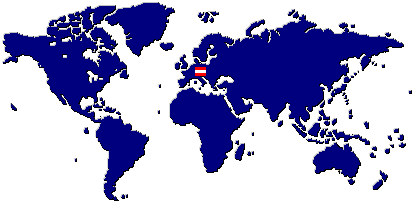



Austria is situated in southern Central Europe, covering a part of the eastern Alps and the Danube region; although it is land-locked, it borders on the Mediterranean area. Austria has common borders with no fewer than eight other countries: Switzerland, Principality of Liechtenstein, Germany, Czech Republic, Slovakia, Hungary, Slovenia, Italy. The country has a wide variety of landscape, vegetation and climate and, situated as it is at the heart of a continent, it has always been a junction for communication links between the trade and cultural centers of Europe.
Austria's border has an overall length of 1,682 miles. Of these, 509 miles are shared with Germany, 291 miles with the Czech Republic, 64 miles with Slovakia, 220 miles with Hungary, 205 miles with Slovenia, 267 miles with Italy, 104 miles with Switzerland and 22 miles with Liechtenstein.
Austria is a federal state with a total area of 32,368 sq. miles (83,858 sq. km) and consists of nine provinces - Burgenland, Carinthia, Lower Austria, Salzburg, Styria, Tyrol, Upper Austria, Vienna and Vorarlberg. Their inhabitants belong to the major European ethnic groups: the Germanic, Neo-Latin and Slav peoples (the Magyars of Hungary are an exception, deriving from the Ural-Altaic group).
The Austrian landscape consists of five sections:
¡@
| Eastern Alps | 20,332 sq, miles | 62.8% |
| Alpine and Carpathian Foothills | 3,658 miles | 11.3% |
| Pannonian Lowlands | 3,658 sq. miles | 11.3% |
| Vienna Basin | 1,424 sq. miles | 4.4% |
| Granite and Gneiss Highlands (Bohemian Massif) |
3,269 sq. miles | 10.1% |
 Austria's highest mountain is the Grossglockner (12,465
ft.) On its way from the Black Forest in southern Germany to the
Black Sea, the Danube flows some 220 miles of its course through
Austria
Austria's highest mountain is the Grossglockner (12,465
ft.) On its way from the Black Forest in southern Germany to the
Black Sea, the Danube flows some 220 miles of its course through
Austria
Austria belongs to the Central European transitional climatic zone. In much of Austria the prevailing winds are westerly and northwesterly. In the West of the country temperature variations between day and night and between summer and winter are less pronounced than in the East. Adequate precipitation is registered throughout most of the country, although the amount decreases continuously from West to East. Austria as a whole can be divided into three climatic regions. The East has a Continental Pannonian climate (mean temperature for July usually above 66°F, annual rainfall often less than 800 mm). The central Alpine region has the characteristic features of the Alpine climate (high precipitation, short summers and long winters).
The remainder of the country belongs to the transitional Central European climatic zone (wet, temperate, mean temperature for July 52 to 66°F, annual precipitation 700 - 2,000 mm depending on location, exposure and altitude).
The variety of Austria's geography and climate has led to a correspondingly wide range of vegetation, in which the main groups coincide to a great extent with the different climatic regions. The woods in Austria's lower regions consist of the standard Central European mixture of oak and beech, giving way to beech and fir above 1600 ft. Fir predominates above 4000 ft. and in turn gives way to larch and stone pine.
Austria is one of Europe's most heavily wooded countries, with 46% of its total area consisting of forests. In the Alpine foreland, the forests are replaced to a great extent by arable land, especially on the northern edge of the Alps, where from a height of about 2000 ft. there is predominantly grassland. Characteristic of the Pannonian region are scrub, mixed deciduous wood and heathland. To the east of Lake Neusiedl in the Burgenland one can find typical salt steppe flora. Austrian wildlife is characteristic of Central Europe: red deer, roe deer, hare, fox, badger, marten, squirrel, pheasant, partridge, etc. Typical Alpine fauna are to be found in the higher mountains: chamois, marmot, Alpine cough and so on. The ibex is also breeding here again. Typical of Pannonian wildlife is the vast bird population of the reed beds which surround Lake Neusiedl, Central Europe's only steppe lake (purple heron, spoon bill, avocet).
According to latest national census (1991) Austria has a population of 7,795,786. According to the latest population statistics (1996) Austria has a population of 8.06 million. This represented an increase of some 264,000 since 1991. In 1996 3.9 million (48.5%) of the population were male, 4.1 million (51.5%) female. For those born in 1996 average life expectancy for men was 73.9, for women 80.2.
Austria's population is 98% German-speaking. Members of the six ethnic groups officially recognized in Austria are found in five of the Austrian provinces. Burgenland is home to Croats and Hungarians, many of whom have migrated to Vienna. Slovenes are found in the Gail, Rosen and Jaun valleys of southern Carinthia and in some villages in the southern part of Styria. Many Czechs and Slovaks live in Vienna and in Lower Austria, particularly in the Marchfeld and Tullnerfeld regions. Romany and Sinti, who were recognized as ethnic groups in 1993, live above all in Burgenland and to some extent in Vienna.
Recognition under the Ethnic Groups Act of 1976 can only be granted to what are called indigenous (autochthonous") ethnic groups, which term is defined as comprising those who have lived in Austria for at least three generations and who are Austrian citizens.
78% of the Austrian population are Roman Catholic while a further 5% are Protestant, most of them belonging to the Augsburg confession. About 4.5% belong to other groups while the remaining 9% are non-denominational and 3.5% provided no information (figures according to the 1991 national census).
The following rights are guaranteed to the legally recognized churches and religious communities - the Catholic Church, the Protestant Church A. and H.C., the Greek Oriental Church (including the Serbian Orthodox, the Romanian Orthodox, the Russian Orthodox and the Bulgarian Orthodox Churches), the Jewish Religious Community, the Islamic Religious Community, the Mosaic Religious Community, the Old Catholic Church, the Methodist Church, the Church of Jesus Christ of the Latter-Day Saints ("Mormons"), the Armenian Apostolic Community, the New Apostolic Church, the Buddhist Religious Society and the Syrian Orthodox Church:
¡@
The freedom of the legally recognized churches and religious communities is guaranteed in article 15 of the Constitution, with the explicit reservation that they are subject to general legislation. Relations between state and church were regulated for the Catholic Church in the Concordat of 1933/34, for the Protestant Church in the "Protestantengesetz" of 1961, for the Jewish Community in the "Israelitengesetz" of 1890, for the Orthodox Church in the "Orthodoxengesetz" of 1967 and for Moslems in the "Islamgesetz" of 1912. Relations with the other legally recognized churches and religious communities were regulated in the Recognition Law of 1874.
According to Austrian law ("law on the religious education of children"), every young person over the age of fourteen can freely choose his or her religion.
Religious education in Austrian schools is not restricted to the Roman Catholic confession: children belonging to smaller churches and religious communities receive religions education in their own confession. Their teachers are paid by the state.